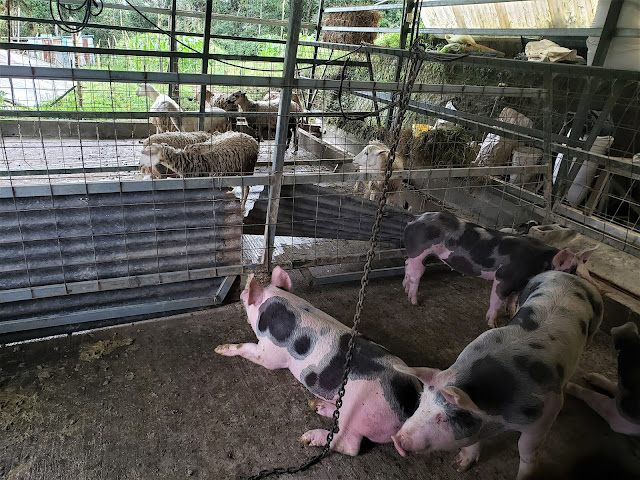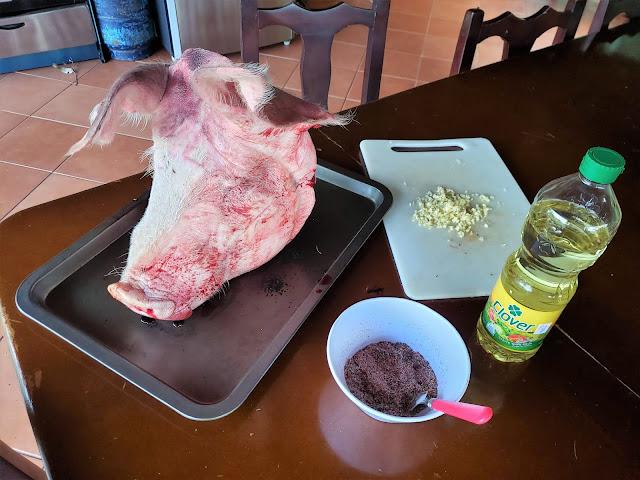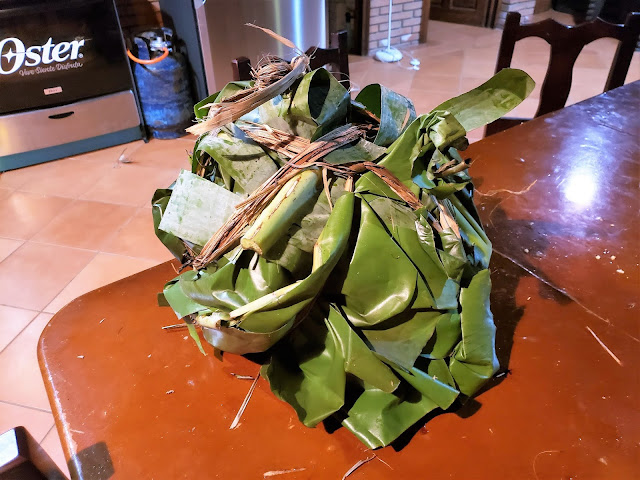Somewhere
along the road between the ADE farm and Cares21, Tomas turned to me with a
smirk on his face and asked, “Do you want to cook a pigs head!?”
This was an unexpected question for
sure.
It’s not everyday that you get asked
to cook the ‘other bits’ of meat that usually don’t make it into a grocery
store.
I had
known that we were hauling a bunch of meat in the back of our van.
I had helped hang the pig up and watched as it
was slaughtered earlier that morning.
Then later, carried up slabs of meat, wrapped in black trash bags, to
store in the deep freezer like I was some sort of Irish hitman.
What I didn’t know, was that in one of those five
or so trash bags was stowed the entire head of a pig.
I agreed, of course, even though
I had never actually cooked a pig’s head before, and suggested that we cook it
in the ground.
I have had experience cooking
things underground during my time in Madagascar, mostly turkeys and geese, and
figured how much different could it be.
Behind my pig’s head stands the
ADE farm.
The ADE farm is based on sustainable
farming practices and is ground-zero for everything we do.
Not so much a place for large-scale production;
the farm situates itself as a center for research and learning of sustainable
practices.
Part of those practices is
using every bit of production.
Whether
that be in the use of organic waste as compost, turning animal excrement into
usable gas, or the eating or selling of every part of the animals that are
harvested.
In the end, those of us that
call ADE home, and many of those around us, get a true authentic farm-to-table experience;
as our pig was also in the process of experiencing.
Cooking
underground is an age-old way of cooking, but it is far from the easiest way of
doing it.
It is a slow process in every
aspect.
It takes considerable manual
labor, planning, and time commitment (a lot of it).
But the results of the process far out way work.
What you are left with is a meat so tender
that it falls off the bone.
Starting early Friday morning I began with the digging of the pit that would become the
oven in which we cooked the pig head.
You have to dig it fairly big, about a meter wide and deep, so that you
have enough earth to insulate the coals.
The work was easy at first, the area had once been a coffee farm, but
about halfway down the ground became more packed and harder to move.
We had
decided that we would cook it overnight, so that it would be ready for lunch
the next day.
So, my next task was to
prep the head so it had time to marinate in the seasonings before entering the ground.
To do this I had to first remove the hair from
the head and the easiest way is to simply burn it off.
Once the majority of the hair was gone, I
lathered the head in a thin layer of oil, mixed an array of seasonings and herb,
and applied them to the head.
Seasoning
the head might be the last thing you would do if you were cooking it a more
modern way, but for the ground the head needs to be wrapped.
For this I used a more traditional method of wrapping
the head in banana leaves.
This not only
protects the head from the dirt, but it also traps in the juices and adds a
little flavor as well.
While
the pig head sat wrapped in its blanket of banana leaves, I set off to start
the fire that would provide us with the coals we needed to cook with.
This was one of the easiest and more fun
steps of the process.
After starting a
small fire in the pit I had dug earlier, we continued to throw in trunks and
branches of dead coffee and cypress trees.
This began the first long time commitment of the process.
The fire soon turned into a bonfire and we
sat, not too closely, and watched as it slowly burned down and left nothing but
red-hot embers.
Once
the fire had burned down, it was ready to cook the pig head.
To create the stove, we raked a layer of
embers aside, sat the wrapped pig head on top of the remaining embers, raked the
layer of embers back on top of the head, and covered the whole pit with dirt.
This whole process has to be done relatively
quickly so that the coals get starved of oxygen and do not begin to burn the
meat.
That quick process is then
followed by a very long one; 15 hours of overnight cooking.
At 11
am Saturday morning. I returned to the pit, happy to find that it had not been
dug up by coyotes during the night.
I carefully
shoveled away the dirt until I found the ball of dried banana leaves hidden
within.
Removing the leaf wrapped head,
still hot from the coals, I took it to the kitchen, and away from the praying
eyes of our dogs, to unwrap it.
Layer
after layer, the leaves turned from dried and crispy to soft, and began to
release the juices and steam they detained inside.
Once removed, the fully cooked head of the
pig was revealed.
Sitting
the head on a baking sheet, we joined it with the rest of the food dishes.
As we all joined in around the table, we began
to cut away pieces for each person and enjoy the farm-to-table experience.
Have you ever cooked or eaten a pig’s head?
What was your
truly farm-to-table experience?










Comments
Post a Comment